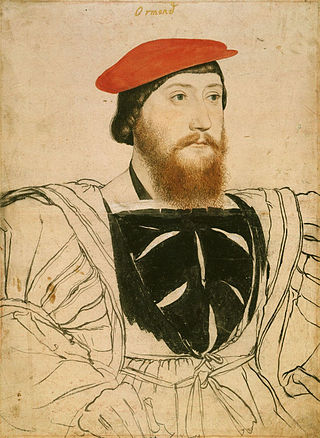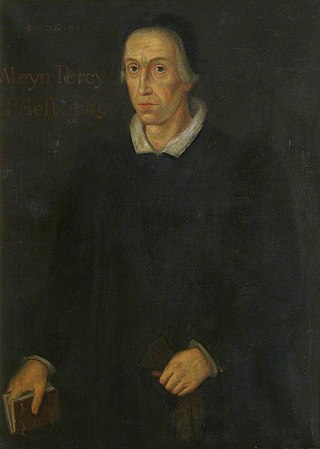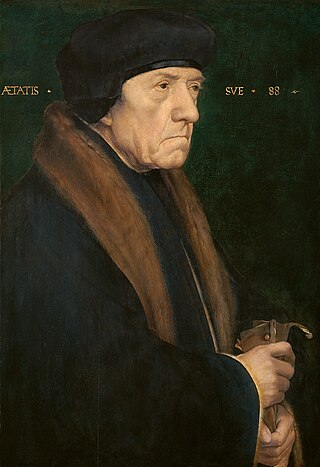Related Research Articles

Henry Percy, 4th Earl of NorthumberlandKG was an English aristocrat during the Wars of the Roses. After losing his title when his father was killed fighting the Yorkists, he later regained his position. He led the rearguard of Richard III's army at the Battle of Bosworth, but failed to commit his troops. He was briefly imprisoned by Henry VII, but later restored to his position. A few years later he was murdered by citizens of York during a revolt against Henry VII's taxation.

Elizabeth Blount, commonly known during her lifetime as Bessie Blount, was a mistress of Henry VIII of England.

Henry FitzRoy, Duke of Richmond and Somerset was the son of Henry VIII of England and his mistress Elizabeth Blount, and the only child born out of wedlock whom Henry acknowledged. He was the younger half-brother of Mary I, as well as the older half-brother of Elizabeth I and Edward VI. Through his mother, he was the elder half-brother of Elizabeth, George, and Robert Tailboys. His surname means "son of the king" in Norman French.

Henry Grey, Duke of Suffolk, 3rd Marquess of Dorset, was an English courtier and nobleman of the Tudor period. He was the father of Lady Jane Grey, known as "the Nine Days' Queen".
Charles Blount, 5th Baron Mountjoy, was an English courtier and patron of learning.

William Parr, Marquess of Northampton, Earl of Essex, 1st Baron Parr, 1st Baron Hart, was the only brother of Queen Catherine Parr, the sixth and final wife of King Henry VIII. He was a "sincere, plain, direct man, not crafty nor involved", whose "delight was music and poetry and his exercise war" who co-authored a treatise on hare coursing. He was in favour with Henry VIII and his son Edward VI, under whom he was the leader of the Protestant party, but having supported the desire of the latter to be succeeded by the Protestant Lady Jane Grey, was attainted by Edward's Catholic half-sister, Queen Mary I. He was restored by her Protestant half-sister, Queen Elizabeth I.

William Herbert, 1st Earl of Pembroke, 1st Baron Herbert of CardiffKG PC was a Welsh Tudor period nobleman, politician, and courtier.
John Palsgrave was a priest of Henry VIII of England's court. He is known as a tutor in the royal household, and as a textbook author.

Henry Algernon Percy, 5th Earl of Northumberland, KG was an English nobleman and a member of the courts of both Kings Henry VII and Henry VIII.

James Butler, 9th Earl of Ormond and 2nd Earl of Ossory, known as the Lame, was in 1541 confirmed as Earl of Ormond thereby ending the dispute over the Ormond earldom between his father, Piers Butler, 8th Earl of Ormond, and Thomas Boleyn, 1st Earl of Wiltshire. Butler died from poison in London.

Gregory Cromwell, 1st Baron Cromwell, KB was an English nobleman. He was the only son of the Tudor statesman Thomas Cromwell, 1st Earl of Essex and Elizabeth Wyckes.

Francis Hastings, 2nd Earl of Huntingdon, KG was the eldest son of George Hastings, 1st Earl of Huntingdon and Anne Stafford, Countess of Huntingdon, the ex-mistress of Henry VIII.

Sir Richard Long was an English politician and courtier, for many years a member of the Privy Chamber of Henry VIII.

Sir Michael Stanhope of Shelford in Nottinghamshire, was an influential courtier who was beheaded on Tower Hill, having been convicted of conspiring to assassinate John Dudley, 1st Duke of Northumberland, and others.
Sir Henry Jerningham KB was an English courtier during the Tudor period. He was a Gentleman Pensioner during the reign of Henry VIII. In the succession crisis of 1553 he was one of the foremost supporters of Mary Tudor, and after her accession was one of her most trusted servants, being appointed Vice-Chamberlain of the Household, Captain of the Yeomen of the Guard, and a member of the Privy Council.

Alan Percy (c.1480-1560) was an English churchman and academic, Master of St John's College, Cambridge, and later Master of Trinity College, Arundel which he surrendered to Henry VIII in 1545.

Arthur James Mason was an English clergyman, theologian and classical scholar. He was Lady Margaret's Professor of Divinity, Master of Pembroke College, Cambridge, and Vice-Chancellor of the University of Cambridge.

Simon Haynes or Heynes was Dean of Exeter, Ambassador to France, and a signatory of the decree that invalidated the marriage of Henry VIII with Anne of Cleves. He became President of Queens' College at the University of Cambridge from 1529 to 1537, and toward the end of his life, was installed Canon of Windsor at Windsor Castle.

Sir John Blount was an English politician. His daughter, Elizabeth, was a Lady-in-Waiting to Consort Queen of England Catherine of Aragon, and later, a mistress to King of England Henry VIII. She bore for Henry VIII his only recognized, illegitimate son, Henry FitzRoy, Duke of Richmond and Somerset. Elizabeth was Henry's mistress beginning in 1514 or 1515, a relationship which continued for about eight years, after the suggestion of an affair was brought to light.

John Chambre (1470–1549) was an English churchman, academic and physician.
References
 This article incorporates text from a publication now in the public domain : "Folbury, George". Dictionary of National Biography . London: Smith, Elder & Co. 1885–1900.
This article incorporates text from a publication now in the public domain : "Folbury, George". Dictionary of National Biography . London: Smith, Elder & Co. 1885–1900.